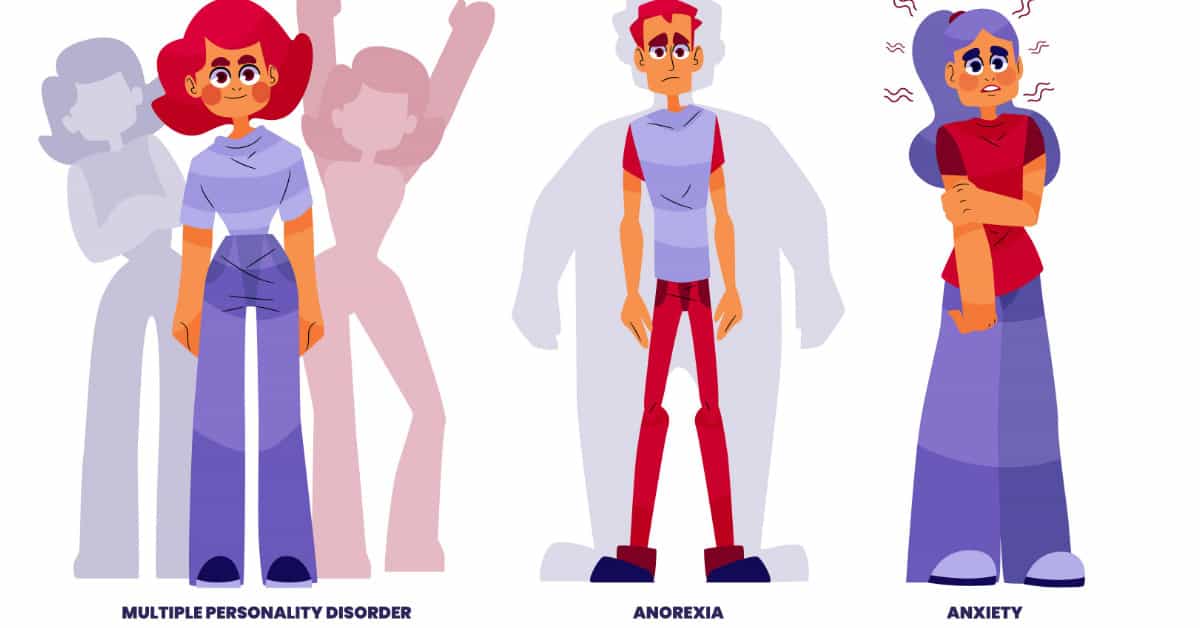A human body is subjected to many diseases, some caused by bacterial infections, some viral, and some fungal infections.
BUT did you know that the way a person eats can also make them get sick?
No wonder eating disorders can seriously damage the body. These conditions can interfere with the physical more than other mental health problems.
Eating disorders are relatively rare but have serious health consequences. The most common are anorexia and bulimia, which mainly affect young women.
They both lead to insufficient calorie intake. In anorexia, the low-calorie intake is due to a poor diet. In bulimia, the patient vomits shortly after a meal without allowing digestion and absorption. There are many similarities, as well as differences between anorexia and bulimia.
Anorexia and bulimia can cause serious bodily changes, like weight loss, weight gain, etc.
However, with these two diseases, people want to lose weight, but their eating habits cause eating disorders.
Although these diseases can affect both men and women, it is observed that women are much more prone to this disease than men. Indeed, 10% of people affected by one or other of these disorders between 15 and 25 years are male. Generally, boys tend to go for bulimia.
In this article, we cover all the essential details for you to understand the difference between anorexia and bulimia so that you are aware of this eating disorder and can check your eating habits.
What is anorexia?
Anorexia is an eating disorder where people eat less or stop eating altogether.
We can check the severity of anorexia by calculating a person’s height and weight, or simply by saying the BMI index.
As a person’s BMI decreases, there is a high risk of severe anorexia.
People want to lose weight; with this tendency, they start to eat little or even in some cases, they simply stop eating. This is when anorexia takes place.
Here are some known symptoms of anorexia;
- It hurts self-esteem
- People with don’t eat or skip meals
- People with anorexia Disconnect from social communities or circle of friends
- People with anorexia are often Unable to concentrate on work
- They also, get food conscious and get leaner.
Anorexia creates a very unusual relationship with the way a person consumes food. There is complete control over how a person consumes food. A routine is followed by how to eat meals, which sometimes makes a person confuse that they are eating more, and as a result, they stop taking food.
Therefore, it is also important to also know that anorexia as an eating disorder can have several side effects like heart problems, low blood pressure, constipation, etc.
So, it is necessary to understand that anorexia must be properly treated by the doctor.
What is bulimia?
Bulimia is an eating disorder where people overeat.
If you want to detect if a person has bulimia, check the person’s weight and height, and measure the BMI. If the BMI continues to increase, there is a higher possibility of bulimia.
Although people want to lose weight, they think they just need to reach an ideal weight.
They stop eating food for a while but cannot stop the urge and therefore start taking more food as before or even in some cases, they just start to overeat. This is when bulimia takes place.
Here are some known symptoms of bulimia;
- Body shape changes and bad body structure.
- Having too much focus on food.
- Have food even after regular meals.
- Very less self-esteem
- Craving an empty stomach.
- Bulimia creates a very unusual relationship with the way a person consumes food.
Similarities Between Anorexia and Bulimia
- Anorexia and bulimia are more common in women than in men.
- People with both anorexia and bulimia may complain of being very cold. This is due to the loss of body fat. Fatty tissue in the skin helps regulate body temperature by insulating it against heat loss.
- Severe anorexia can cause a sudden drop in blood pressure.
- Due to poor circulation in the hands and feet, they feel cold to the touch.
- Nail and hair growth is poor, both in anorexia and in bulimia. The nails are rapidly growing skin appendages. A considerable amount of energy and nutrients are required for nail and hair growth due to the rapid cell divisions and associated maturation. Due to food restriction, the daily requirement of these micronutrients and macronutrients is not being met. Therefore, nails and hair grow slowly.
- Excessive stress in the body due to a chronic lack of sufficient caloric intake in both anorexia and bulimia can be the earliest cause of irregular periods. Because the menstrual cycle has cerebral cortical control, stress, emotional upheaval can also cause menstrual irregularities. Chronic malnutrition will lead to disruption of follicle maturation in the ovaries. This leads to irregularities in the plasma levels of estrogen and progesterone during the menstrual cycle.
- A number of skin features associated with anorexia and bulimia are caused by chronic insufficient and severe nutrition. They can get fungal infections on the fingers (inter-digital intertrigo), slightly raised red rashes (popular), early hair loss and lack of hair growth (telogen effluivium), bluish discoloration of the fingers, toes, and sometimes face (acrocyanosis), painful, painful nail condition called paronychia, yellowish or orange discoloration of the palms and soles (carotenoderma), itching all over the body (pruritus), acne, stretch marks on the skin (striea distensea), darkening of the skin (hyperpigmentation), the reticulate purplish appearance of the skin (lifo reticular), sores at the corners of the mouth (angular stomatitis), dermatitis around the mouth, eyes, ears, anus, and limbs (acrodermatitis enteropathica).
- Bad breath is a common complication of anorexia and bulimia, although the mechanism is different.
- Depression is the most common psychiatric condition encountered in anorexia and bulimia.
- Although these two diseases, anorexia and bulimia, are caused by eating disorders, they occur with weight loss.
Differences between anorexia and bulimia
- Anorexic patients do not eat while bulimic patients eat, but try to purge themselves using various methods.
- Patients with anorexia have a distorted perception of body image, unlike bulimics. They just use extreme methods to stay slim.
- Patients with anorexia do not use purging methods, unlike bulimics. Many purge methods are used. The most commonly used method is vomiting. Most of the time, it is enough to insert a finger in the throat to trigger the gag reflex and induce vomiting. Some use salt water. Another method is unsafe excessive use of laxatives. Rigorous exercise is also a known method of purging.
- People with anorexia are skinny, while those with bulimia have a normal weight.
- Adolescents and young people are the usual victims of anorexia, while older women have bulimia.
- Their physical symptoms are different.
- Treatment for anorexia begins with making the sufferer gain weight and then addressing psychological issues. In contrast, treatment for bulimia requires addressing psychological issues, and having the person follow good eating habits.
Diagnosis and treatment
Anorexic or bulimic disorders, which lead to a significant loss or gain in weight, are generally quickly detected by those around them. Bulimic disorders without weight gain are more difficult to see. Other symptoms can also be watched.
When the person makes themselves vomit regularly so as not to change their weight, the salivary glands become swollen, like a squirrel having hazelnuts on either side of the mouth. Due to vomiting, signs may also be visible such as a mark on the upper teeth from gastric acidity on the enamel or erythema on the back of the hand called the “Russell’s sign.”
Early detection of these eating disorders allows for better multidisciplinary outpatient care. We must take into account both the somatic dimension (the body is malnourished and suffers), the nutritional dimension (eating habits that must be changed), and the psychological dimension (with very strong and old anxieties).
Hospitalization remains essential and very useful in many situations, but it is recommended to start treatment with outpatient care. If there is a vital risk, if the patient has suicidal desires (characterized depressive moment) or the environment is overwhelmed, hospitalization is necessary. The care then continues as part of a follow-up by a multidisciplinary team: doctor, nutritionist, and psychiatrist or psychologist.
Treatment for both of these conditions requires the use of antidepressant medications to relieve the psychological symptoms associated with them. The emphasis in the treatment of anorexia is on the weight gain by the sufferer; only after when she is in the correct weight can she be treated with medication. In bulimic, the goal is to make him follow good eating habits and treat his psychological problems.
As with all health problems, the key to recovery lies in the early detection and immediate treatment of the disorder. It also helps if the family is more attentive and concerned about the person suffering from these disorders.
How can you support someone who is showing symptoms that may be related to an eating disorder?
Do not hesitate to broach the subject with him/her. List your observations about food intake and your concern for their health.
Your child may not admit their problem. Do not insist at this moment, so as not to make the situation even more difficult for him/her.
Do not force your child to eat; it will only increase the conflict he has with food. You can get him his favorite foods or foods he wants to eat more often if he wants to.
Don’t comment on your teen’s weight and appearance, whether positive or negative. It would only exacerbate his bad perception of his body.
Medical consultation may be necessary to assess your child’s state of health.
Consulting a nutritionist may be relevant. It can reframe false beliefs about diet and weight loss.
A follow-up with a professional should be set up in order to develop self-esteem and learn to control anxiety.
See Also
Obstructive and Restrictive Lung Disease
Diastolic Vs Systolic Heart Failure









